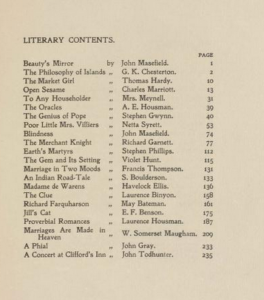The Misconception of Love & Marriage in Francis Thompson’s “Marriage in Two Moods”
Introduction:
There are topics and conversations that no matter the time, year, or decade will always be relevant, relevant enough to keep asking questions about said topic and the many opinions that can come from it by having conversations. One of the topics that will always warrant discussion is love, love and marriage will always be relevant because everyone seeks companionship in someone, people want a partner with whom they can share everything, someone to spend the rest of their lives with. The topic of love is everlasting, it’s so old that you can go back to ancient literature and find things that talk about love and marriage, one of the findings that could capture an individuals eye is Marriage in two moods, which was written by Francis Tompson and was released in the magazine titled The Venture. The two-page poem follows a narrator that describes the everyday life of love, almost describing the concept as a repetition. Although short spanning roughly two pages it is fast, however, despite the transient nature of the poem it can invoke many questions for the reader, an individual reading this for the first time can assume that the poem is describing how great love is and is very much romanticizing the idea of marriage, but if one were to read the poem a few more times it a different message could be conveyed, instead of the glamourizing of love could Thompson be questioning the idea of it? The question goes from “How great is love?” to “Is love a misconception?”. By analyzing a few trusted scholarly sources, and analyzing the poem this exhibit will better understand what Thompson truly meant in his poem, and whether or not love is great or bad.
Table of contents:

Laurence Housman and Somerset Maugham, “The Venture”, Pear Tree Press, 1903
This is a table of contents from the magazine that this text was chosen, this is a list of stories that are included in the Venture. The Venture has a lot of poems that are similar to Marriage in Two moods, poems that are short but effective in the message that it’s trying to convey. Although the themes vary among the poems they can help create conversation in terms of what the author was trying to say, messages are important but one of the most important aspects of a great writer is to let the reader come to their own conclusion. Why this image is important to the exhibit because it will allow readers a better understanding of why this research is important because the most simple of things can still be talked about and expanded upon.
Love as a delusion and representations in modern film:
A few lines that can highlight the importance of this exhibit are in the first few lines of the poem, the poem starts off from an initial standpoint it does seem like the author is trying to insinuate that love and having marriage be part of your everyday life seems great, but with as the poem goes on it seems that the message that Thompson is trying to convey is different than the initial thoughts, “Daily pleasure grows a task; Daily smiles become a mask. Daily growth of unpruned strength Expands to feebleness at length” (Thompson 131). Thompson is now insinuating that as the marriage goes on, and as the years go on love becomes different than what it once was, it loses the feeling it once used to be thus the feelings one has are not the same as when the marriage started and that love starts to become a decay, as Thompson note earlier on in the poem (Thompson 131). This passage can be related to Erotomania, which is a form of delusional disorder, it is a rare condition in which an individual develops the belief that he or she is loved from afar by another person (Kelly, 2018), why is this term relevant is because it can explain the so-called “Misconception of love and marriage” that Thompson is trying to get across, that love can be a delusion and that the person one loves may not be the one for them, this is important because love and marriage are sacred when an individual marries someone it is expected that they cherish that person for years to come, therefore one must find the right partner for them.
In modern cinema, more specifically romantic ideals and myths like the soul mate or the “One” are relevant (Oria, 2018). Now, one thing that can actually be beneficial for relationships in real life is when these movies show a wide variety in their representation of love, often showing tumultuous, dull, awkward or unhappy relationships. The couples featured in these films often require “work” to stay afloat, something rarely explored by mainstream cinema (Oria, 2018). The majority of indie romcoms do try to present themselves as a happy fairytale, however, there are a considerable amount of films that do offer a more self-conscious look at love (Oria, 2018), why this is important to note on is because love can be toxic and not knowing how to deal with it can put both willing participants in harms away, therefore it is crucial that modern films can display the negative side of love, which can help people understand what to do and what not to do when pursuing a romantic relationship.
Love and marriage as a repetition/marital satisfaction:
As the poem goes on, so does this deeper message of marriage and everyday life revolving around the concept, “Love to daily uses wed Shall be sweetly perfected. Life by repetition grows Unto its appointed close:” (Thompson 132). This passage from the poem is also interesting because Thompson is suggesting that the daily life of marriage starts to become a routine, that a married couple does the same thing every day, every week, every month, every year until either the marriage is done or both participants pass away. Thompson is implying that love and marriage after a certain amount of time start to become a repetition within itself, this can be a case of marital satisfaction, a study for the marriage project found that more than 50% of wives and more than 90% of husbands experienced insignificant or minimal declines in their marital happiness across the first 16 years of marriage (Birditt, Hope, Brown, & Orbuch, 2012 as cited in Karney & Bradbury, 2020), the study also found that most couples who start their marriage happy stay happy for long periods of time. (Karney & Bradbury, 2020). One of the reasons for this is that by the time a couple gets married, many of the factors that determine where the relationship goes might already be set in place (Karney & Bradbury, 2020). This study is interesting because it does paint the picture that marital satisfaction is a good thing, however, it can also be seen that marital satisfaction plays into the narrative that Thompson is trying to convey, that the stability and mere “satisfaction” of marriage start to become a loop for years. Now although marital satisfaction isn’t a bad thing either, it does not always mean that it is a good thing. Marriage is a complicated process, therefore it’s important that one knows what they are doing if one wants a successful marriage and to keep the love.
Endogamy in marriage:
Marriage through the years varies, as time goes on the diversity of marriage starts to become more apparent, however, during the years, there are also marriages that follow the pattern of endogamy, which essentially means that racial and religious groups marry within their own groups. This is done because families want to “preserve” their race and religion for future bloodlines (Rosenfeld, 2008). Now although this concept isn’t too apparent in the text by Thompson, it does bring a new sense to the concept of marriage, and discrimination. Now yes this factor plays no part in what Thompson says about marriage, but it does bring a new perspective to the era that this story takes place. That there is discrimination and exclusion from love and that the stubbornness to stay within one’s religion and race could play a part in the downfall in marriage.
Marriage through the feminist lens:
Another article that doesn’t have any relevance to Thompson’s text is “Marriage, morals, and progress: J.S. Mill and the early feminists” written by Janelle Pötzsch. The article like the previous definition and thought of endogamy brings another perspective to love. The article notes the comparison between marriage and slavery to highlight women’s vulnerability that comes with their poor status. (Potzsch, 2021). Why I feel this is significant because it can help people better understand what love really is through the feminist viewpoint, that sometimes love isn’t what it seems to be, that it can be forced which in turn makes the marriage unsuccessful, which can tie into what Thompson writes in his poem, “Daily smiles become a mask. Daily growth of unpruned strength Expands to feebleness at length” (Thompson 131).
Conclusion:
“Like Wisdom, by repeating it? By the oft-repeated use, All perfections gain their thews; And so, with daily uses wed, Love, too, shall be perfected” (Thompson 132). Those are the last lines that are said in Marriage in two moods. Marriage is a complicated topic to discuss, however, through analyzing the poem and other outside sources, Thompson is saying that Marriage is a misconception, that it’s not what it’s made out to be, and that it may not be the best thing that could happen to an individual. But that doesn’t mean that it’s all bad, just not all good. If one wants a successful marriage they have to work for it, even through the bad one must understand that marriage will have its ups and downs, marriage may be a misconception, but it is far from being terrible. Overall, Marriage in two moods may not be the most popular poem about love and marriage, but it’s a poem that although highlights the negative aspects of love, can show hints of the good side and what to look forward to. That love may be hard, and marriage may be trouble, but in the end, it’s worth it if the person is “The One”.

“Beautiful Paintings Depict Elegant Everyday Moments of Interracial Couples: Interracial Art, Artist Paint, Painting.” Pinterest, 13 Aug. 2019, https://www.pinterest.ca/pin/481603753902805458.
Work Cited
Thompson, Francis “Marriage in two moods.” The Venture, Pear Tree Press, 1903. 131-132
Kelly, Brendan D. “Love as Delusion, Delusions of Love: Erotomania, Narcissism and Shame.” Medical Humanities, vol. 44, no. 1, 2018, pp. 15–19., https://go.exlibris.link/cmt9LvpG. Accessed 27 Oct. 2022.
Karney, Benjamin R., and Thomas N. Bradbury. “Research on Marital Satisfaction and Stability in the 2010s: Challenging Conventional Wisdom.” Journal of Marriage and Family, vol. 82, no. 1, 2020, pp. 100–116., https://go.exlibris.link/v6qgT9zS. Accessed 27 Oct. 2022.
Oria, Beatriz. “Love on the Margins: The American Indie Rom-Com of the 2010s.” Atlantis (Salamanca, Spain), vol. 40, no. 2, 2018, pp. 145–168., https://go.exlibris.link/wvzQqT5w /Atlantis-2018-40.2.08. Accessed 27 Oct. 2022.
Pötzsch, Janelle. “Marriage, Morals, and Progress: J.S. Mill and the Early Feminists.” History of European Ideas, vol. 48, no. 6, 2022, pp. 795–810., https://go.exlibris.link/rdQVjYCk.Accessed 27 Oct. 2022.
Rosenfeld, Michael J. “Racial, Educational and Religious Endogamy in the United States: A Comparative Historical Perspective.” Social Forces, vol. 87, no. 1, 2008, pp. 1–31., https://go.exlibris.link/y1X9NGcK. Accessed 28 Oct. 2022.
